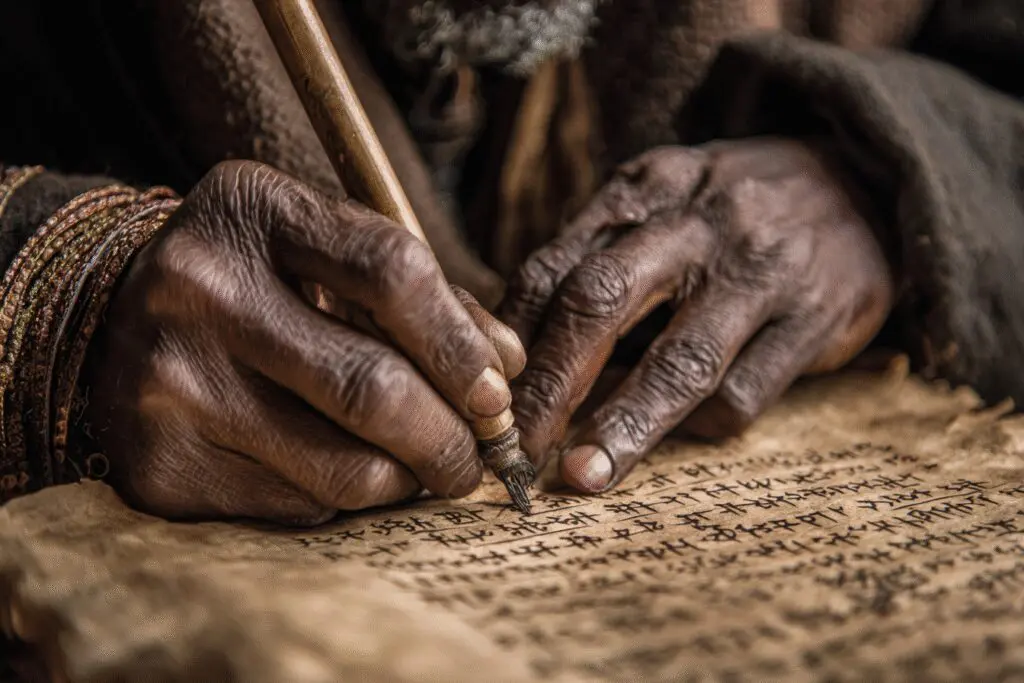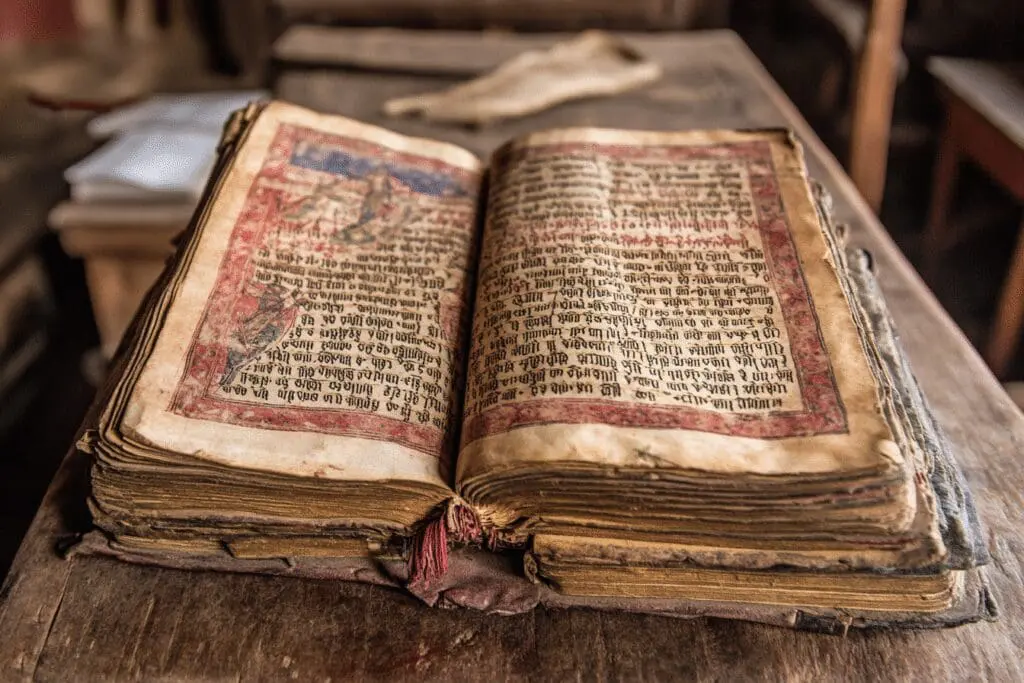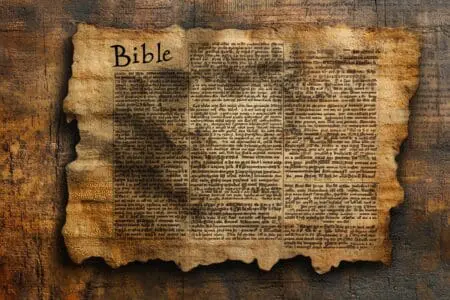Ever have that strange feeling of seeing something for the first time, yet it feels weirdly familiar? That’s the Ethiopian Bible for a lot of people. It’s a Christian holy book, sure. But it’s also packed with texts you won’t find anywhere else, chapters the rest of the world completely lost for ages. That discovery immediately brings up a huge question: When was the Ethiopian Bible written? Answering that isn’t about finding one date on a calendar. It’s about diving headfirst into the ancient world. We’re talking about a journey through lost empires, past the patient work of monks, and into a faith that survived against all odds in the African highlands.
This isn’t a story about someone writing a book from scratch. It’s a story about careful translation. About preservation. About pure devotion. To really get it, we have to peel back the layers. We have to start with the first whispers of Christianity in Ethiopia and follow the scribes who spent their lives copying these words, creating one of the oldest and most mind-blowing biblical traditions on the planet.
More in Bible Category
How Many Words Are in the KJV Bible
Key Takeaways
- It Wasn’t a Single Event: The Ethiopian Bible wasn’t “written” all at once. Instead, think of it as a long process of translating older Jewish and Christian texts into the ancient Ge’ez language.
- Deep Christian Roots: The Aksumite Kingdom, in what’s now Ethiopia, made Christianity its state religion way back in the 4th century AD. This meant they suddenly needed scriptures their people could actually read.
- The Big Translation Project: The most important translation work happened in the late 5th and early 6th centuries. A group of missionary monks, known as the Nine Saints, get most of the credit.
- More Books, More Story: The Ethiopian Bible has a “broader canon.” That’s a fancy way of saying it includes books that aren’t in Protestant or Catholic Bibles, like the wild and fascinating Book of Enoch.
- The Proof Still Exists: Unbelievably, ancient copies still survive. The Garima Gospels, for example, have been carbon-dated to as early as the 4th to 7th centuries, making them some of the oldest decorated Christian gospels in the world.
So, Where Did This All Even Begin?
You can’t find the origin of a Bible without first finding the origin of the faith. The book didn’t just materialize. It grew from a community that desperately needed it. The story of how Christianity first came to Ethiopia is a wild ride all on its own, and it really sets the stage for what came next. It’s a direct link to the apostles that most of the Western world has no idea even exists.
Wait, Ethiopia is actually in the Bible?
You bet it is. The origin story for Ethiopian Christianity comes straight out of the New Testament. You can find it in the Acts of the Apostles. The book tells the story of a high-ranking official, a treasury chief serving the Queen of the Ethiopians. He had made the long journey to Jerusalem to worship.
On his way home, he was reading a scroll of the prophet Isaiah. The Apostle Philip, guided by the Holy Spirit, walked up to his chariot and asked a simple question: “Do you understand what you’re reading?” The official’s reply was honest. “How can I,” he said, “unless someone explains it to me?”
Philip hopped in. He explained how the ancient prophecy pointed directly to Jesus. The official was so moved that the moment they saw water, he asked to be baptized. He became the very first Ethiopian Christian, kickstarting a legacy. That story, from Acts 8:26-40, is seen as the seed of it all. It forged a direct connection to the age of the apostles from day one.
But when did it become the official religion?
That first conversion was a huge moment, but the faith didn’t take over the entire nation overnight. That happened about 300 years later. In the 4th century AD, the Kingdom of Aksum was the regional superpower, and its ruler was a man named King Ezana.
Legend says two young Syrian Christians, Frumentius and Aedesius, were shipwrecked and taken to the Aksumite court. They were so bright and trustworthy that they quickly gained influence. Frumentius even became a tutor to the young prince, Ezana. He used his position to share his faith with the royal family and traders passing through.
By the time Ezana became king, he was already a believer. Around 330 AD, he made a monumental decision: he declared Christianity the official religion of his entire kingdom. Aksum became one of the very first empires on Earth to do so. That royal decree created an immediate, urgent need for scriptures in the local language.
Okay, So When Did They Actually Start Writing the Bible Down?
The faith was official. The king was on board. What was next? Getting the holy books into the hands of the people. Before this, church services were probably in Greek, the common language of the Eastern Roman Empire where the first missionaries came from. But for the faith to feel like it truly belonged to Ethiopians, it had to speak their language. This is the moment the Ethiopian Bible truly begins to be born.
It was a colossal undertaking.
This process wasn’t fast. It wasn’t easy. And it wasn’t done by one person. The real answer to “When was the Ethiopian Bible written?” lies in this long, painstaking effort to turn Greek texts into the beautiful script of Ge’ez.
Did they write it all in one go?
Not a chance. Don’t picture a single author at a desk. Picture teams of dedicated scholars working on a translation project that would last for generations. For the Old Testament, they worked mainly from the Septuagint—a popular Greek translation of the Hebrew scriptures. The New Testament also came from Greek sources.
The language they translated into was Ge’ez. This is an ancient Semitic language, the official tongue of the Aksumite Kingdom. Nobody speaks Ge’ez on the street anymore, but it remains the holy, liturgical language of the Ethiopian and Eritrean Orthodox Tewahedo Churches. It’s their version of Latin—the language of prayer, of scripture, of ancient hymns. Translating the Bible into Ge’ez cemented its holy status for thousands of years.
Who were the first translators?
Tradition gives the credit for most of this early, vital work to a group called the Nine Saints. These were monks who, the story goes, came from all over the Roman Empire—places like Syria and Constantinople. They were likely fleeing persecution after a major church meeting, the Council of Chalcedon in 451 AD, which caused a huge rift in the Christian world.
The church in Ethiopia, along with others like the Coptic and Armenian churches, disagreed with the council’s conclusions. This is what led them to be called “Oriental Orthodox.”
The Nine Saints showed up in Aksum in the late 5th century and were welcomed for their deep faith and knowledge. They established monasteries that became powerhouses of learning and spirituality. Then they took on the gigantic task of translating the Bible into Ge’ez. This window of time, from the late 400s into the early 500s, is the key period when the first written Ethiopian Bible was created. Their work formed the bedrock of everything that followed.
What Makes the Ethiopian Bible So Different, Anyway?
This is where it gets really wild. The Ethiopian Bible isn’t just another translation. It’s a unique library of texts. The Ethiopian church grew up in relative isolation from the centers of power in Rome and Constantinople. Because of that, it held onto a collection of books—a biblical “canon”—that is completely its own. While other churches were debating which books were in and which were out, the Ethiopian tradition was busy preserving ancient texts that everyone else was forgetting.
You mean it has extra books?
It sure does. A lot of them. The Ethiopian Orthodox Tewahedo Church has what’s called the “broader canon.” It has all the books you’d find in other Bibles, plus a bunch of others. A complete Ethiopian Bible can have up to 81 books. For comparison, the Protestant Bible has 66.
Some of these extra texts are incredible.
- The Book of Enoch: This is the most famous one. It’s an ancient Jewish apocalyptic book said to be written by Enoch, Noah’s great-grandfather. It’s filled with vivid visions of heaven, angels, demons, and the end of the world. The craziest part? The New Testament actually quotes it! The Book of Jude (1:14-15) directly references Enoch’s prophecies. Early Christians loved this book, but most churches eventually dropped it. The Ethiopian church kept the whole thing.
- The Book of Jubilees: Sometimes called the “Little Genesis,” this book retells the stories from Genesis and Exodus. It claims to be a special revelation God gave to Moses on Mount Sinai.
- Meqabyan 1, 2, & 3: These are totally different from the books of Maccabees in the Catholic Bible. Their stories focus heavily on the themes of martyrdom and keeping the faith when things get tough.
- The Book of Joseph ben Gurion (Josippon): A history of the Jewish people written from a Jewish perspective, covering everything from Adam to the destruction of the Second Temple.
So why did they keep these books?
It wasn’t a mistake. The Ethiopian Orthodox Tewahedo Church believes its collection is older and more complete. From their point of view, they didn’t add books—other churches took them away.
This was only possible because of Ethiopia’s unique geography and history. The mountainous highlands of the Kingdom of Aksum acted as a natural fortress, isolating it from the endless theological arguments that were raging in the Roman and Byzantine worlds. They simply held on tight to the traditions they’d received from the first missionaries. They kept reading and revering books like Enoch and Jubilees long after they had fallen out of fashion elsewhere. That isolation turned Ethiopia into a kind of theological time capsule, preserving a version of the biblical canon that would have otherwise vanished.
Can We Actually See These Ancient Bibles?
Talking about 1,500-year-old books can feel a bit unreal. Is there any actual, physical proof? Did any of the first copies survive? The answer is a spectacular, mind-blowing yes. The monasteries of Ethiopia have been sitting on some of Christianity’s greatest hidden treasures for centuries.
These ancient, weathered books are the most tangible proof we have. They aren’t just artifacts. They’re world treasures.
Are the very first copies still around?
Maybe not the absolute first drafts, but unbelievably early copies have survived. The most stunning examples are the Garima Gospels.
These two ancient books are kept in the Abba Garima Monastery in northern Ethiopia. For centuries, the monks insisted they were written in a single day by Abba Garima himself, one of the original Nine Saints. The legend says God made the sun stand still in the sky so he could finish his work.
For a long time, Western scholars just smiled and nodded, dismissing it as a nice story. They figured the books were from the 10th or 11th century. But then came modern science. In the 2010s, researchers were finally allowed to perform radiocarbon dating on the manuscripts. The results were shocking. The books dated to between 390-570 AD and 530-660 AD. This means they could have been made during the actual lifetime of Abba Garima. This discovery, which you can read about from sources like the University of Oxford’s research network, makes the Garima Gospels perhaps the oldest illuminated Christian manuscripts in existence.
How did they make and save these books?
Making a book like this was an act of worship. Scribes, nearly always monks, would prepare pages from vellum—a fine parchment made from animal skin. This stuff was tough and made to last. The ink was all-natural, mixed from soot, minerals, and plants to create the blacks, reds, and golds of the text and illustrations. Then began the slow, meditative process of copying every single letter by hand.
It’s a miracle these books survived at all. Their survival is thanks to a few things. First, many monasteries were built in remote, high-altitude spots that were hard for invaders to reach. Second, the cool, dry air of the Ethiopian highlands is perfect for preserving delicate parchment. Finally, these books were treated as the holiest objects imaginable. They were guarded jealousy, rarely touched, and stored in special wrappings, which saved them for us to see today.
How Did the Language and Text Evolve Over Time?
The story didn’t stop in the 6th century. The Ethiopian Bible was a living document inside a living faith. The translation was refined and revisited again and again across the vast sweep of Ethiopian history. The text we have today is the result of that long, dynamic evolution.
So they didn’t just translate it once?
Definitely not. As the centuries rolled by, Ethiopian scholars would go back to the Ge’ez texts. Sometimes they got their hands on newer manuscripts in other languages, like Coptic or Arabic, and used them to check their work. This let them clarify difficult passages and fix small errors that had inevitably crept in after centuries of being copied by hand.
You can think of it like updating software. The basic “operating system” was installed in the 5th and 6th centuries, but scholars kept releasing “patches” and “upgrades” to make it run better. This was especially true during Ethiopia’s medieval golden age, from the 13th to the 16th centuries. This constant work shows just how vital the Bible was to the nation’s spiritual and intellectual life.
When did they finally settle on the full list of books?
That’s another one with a messy answer. The core books were set early on, but the final, official list of all 81 books of the “broader canon” took a long, long time to nail down. Different monasteries sometimes had slightly different collections.
The Roman Catholic Church locked in its canon at the Council of Trent in the 1500s. The Ethiopian Orthodox Tewahedo Church was way more fluid. There was no single big meeting that made a final ruling for everyone. The general agreement on the final list seems to have firmed up much later, maybe not even completely until the 17th or 18th century. It’s a perfect example of the Ethiopian tradition: valuing slow, ancient agreement over sudden, top-down rules.
What Does This All Mean for the Faith Today?
This isn’t just history. It’s the beating heart of one of the planet’s oldest Christian communities. The ancient roots of the Ethiopian Bible, its one-of-a-kind library of books, and the beautiful Ge’ez language—they are all sources of immense pride and identity for millions of Ethiopian Orthodox Christians. This Bible is their direct, unbroken line to the ancient world.
Why is this history such a big deal for Ethiopians?
For Ethiopian Christians, this story is everything. It’s proof that their faith is ancient and authentic. They are fiercely proud that their Christianity wasn’t a colonial import but is woven into the very soul of their nation, stretching all the way back to the time of the apostles. The Ethiopian Bible is the ultimate symbol of that independence. It represents a faith that stood its ground, developing its own deep theology and stunning art while cut off from the rest of the Christian world.
The Ge’ez language, kept alive by the Bible, isn’t just for church. It’s the language of their saints. The unique books, like Enoch, are a sacred trust—a piece of God’s story they were chosen to protect for the rest of us. This Bible is a monument to an unbreakable faith and the cornerstone of a national identity.
So, what’s the short answer to “When was the Ethiopian Bible written?”
If you had to explain it to a friend, you could break it down into three parts.
First, the need for the Bible exploded in the 4th century, after King Ezana made Christianity the official religion. Second, the real writing—the massive translation project into Ge’ez—took off in the late 5th and early 6th centuries, led by the legendary Nine Saints. And third, the Bible’s final shape, with all its extra books, took many more centuries to fully settle.
The most incredible part? We can still see the proof today. The Garima Gospels are a physical bridge to that distant past, a beautiful, silent witness to the moment the word of God first learned to speak in the language of Ethiopia. It’s not the story of a single day. It’s the story of a millennium.
Frequently Asked Questions – When Was the Ethiopian Bible Written

When was the Ethiopian Bible finalized and what does this timeline signify?
The Ethiopian Bible’s translation and canon were finalized between the 4th and 17th centuries, signifying a long process of development and preservation that spans over a millennium.
What are some of the ancient manuscripts that indicate when the Ethiopian Bible was written?
Ancient manuscripts such as the Garima Gospels, dating from A.D. 330 to 650, are some of the oldest copies that show the Ethiopian Bible was written early in Christian history.
Why is the Ethiopian Bible considered larger and different from other Christian Bibles?
The Ethiopian Bible has a broader canon with up to 81 books, including unique texts like the Book of Enoch, Jubilee, and Meqabyan, which are not found in other Christian Bibles.
Who were the Nine Saints and what role did they play in the Ethiopian Bible’s history?
The Nine Saints were monks from other lands who arrived in Ethiopia in the late 5th century, helping to accelerate the translation of the Bible and strengthen the Ethiopian Christian Church.
When did the translation of the Ethiopian Bible into Ge’ez begin?
The translation of the Ethiopian Bible into Ge’ez began in the 4th century, with work gradually progressing through the 4th and 5th centuries.




